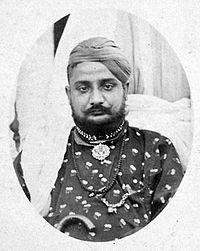Chambial
This article may require cleanup to meet Wikipedia's quality standards. The specific problem is: Still needs cleaning up and division into more sections. (December 2015) |
चम्बिआल राजपूत | |
|---|---|
 The Chambial rajput are of the Hindu Rajput Caste | |
| Regions with significant populations | |
| Chamba Himachal Pradesh • India | |
| Languages | |
| pahari • Punjabi • Hindi • | |
| Religion | |
Chambial (Chambiyal) is a powerful Kshatriya Hindu Rajput clan in Himachal Pradesh.[1]They speak Chambiali but some of them speak Hindi.
The clan is originally from Chamba but it has spread throughout Himachal Pradesh and some parts of Punjab.
Location and History
Many interesting anecdotes have been recorded about the clan. Chambial, as a royal dynasty and a feudal title in several Indian languages, literally means "lord" or King. The Chambial are the rulers of Chamba region.[clarification needed] The Rajas of Chamba belong to the Suryavanshi and Kashyap Vansh of the Rajput lineage.[citation needed] The original home of the family is said to have been from North India.
These Himachali Rajput clans suffixed their family names after their proper names; for instance, Katoch Rajas suffixed Chandra, Chambials suffixed Varman, Suketias suffixed Sen, while Jaswals and Sibials suffixed chand after their names.
Though historical records date the history of the Chamba region to the Kolian tribes in the 2nd century BC, the area was formally ruled by the Maru dynasty, starting with the Raju Maru from around 500 AD, ruling from the ancient capital of Bharmour, which is located 75 kilometres (47 mi) from the town of Chamba. In 920 AD, Raja Sahil Varman (or Raja Sahil Verma) shifted the capital of the kingdom to Chamba, following the specific request of his daughter Champavati (Chamba was named after her). From the time of Raju Maru, 67 Rajas of this dynasty have ruled over Chamba until it finally merged with the Indian Union in April 1948, although Chamba was under British sovereignty from 1846 to then.

Maru is said to have been at first a religious devotee whose life was given up to tapas or self-mortification. He afterwards married, and three sons were born to him. When they reached manhood he bestowed a kingdom on each of them. Leaving the eldest in the ancestral home, he traversed the Panjab with the other two, and settled one of them in the mountains near Kashmir. Accompanied by Jaistambh, the youngest, he then penetrated to the Upper Ravi Valley through the outer hills, and having conquered that territory from the petty Ranas who held it, he founded the town of Brahmapura and made it the capital of a new State. This event is believed to have taken place about the middle of the sixth century A.D. Bandral was the offshoot of Chambial Rajputs but in course of time they became popular by the name Called Chambial Rajputs.
Administration

There have been a total of 67 rajas who have ruled Chamba[2] district since the Principality of Bharmour was established in the 6th century, beginning with Raja Maru. These kings belong from Chambial[3] Dynasty. Indeed, it is believed to have been an isolated case in the history of India that the Chamba kingdom remained independent without interference for over 1000 years.Before Raja Sahila Varman, however, the territorial extent of the state of Chamba was ill-defined and was more a loosely based territory, marked by disunity. Chamba state was run by Ranas, petty rulers who were allocated locally governed areas known as "fiefdoms" and treated them as their own virtually independent kingdoms. It wasn't until the reign of Sahila Varman that these Raja lords were subjugated and the district of Chamba was consolidated formally as a unified entity.The rajas of the Chamba Kingdom, ruling from the capital in Chamba divided the kingdom into 5 mandalas, later termed wazarats. These sub-territories consisted of Chamba, Bharmour, Bhatti, Churah and Pangi.
References
- ^ Sukhdev Singh Charak] (February 11, 2007). "Prominent Rajput clans & their main centers". [source: History and Culture of Himalayan States by Professor Sukhdev Singh Charak].
- ^ "The official site of district Chamba history". Retrieved 9 December 2015.
- ^ John Hutchison. History of the Panjab Hill States, Volume 1. Asian Educational Services, 1933. pp. 1101 pages. ISBN 9788120609426.
